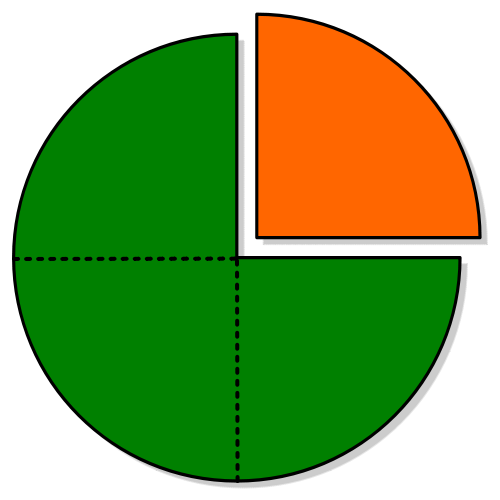Fractions Lesson: Key Concepts, Types, & More
Lesson Overview
- What Are Fractions?
- Types of Fractions
- Understanding Fractions on a Number Line
- Simplifying Fractions
- Adding and Subtracting Fractions
- Multiplying and Dividing Fractions
- Real-Life Applications of Fractions
- Practice Problems for Fractions
A fraction is a mathematical way of representing parts of a whole. Fractions are used in everyday life, whether it's sharing food, measuring ingredients for a recipe, or dividing something into equal parts.
In this lesson, we will explore what fractions are, how to read and write them, and how to perform basic operations with them. You'll learn how to identify fractions, simplify them, and solve problems involving fractions.
What Are Fractions?
A fraction consists of two parts:
- Numerator: The top number that represents how many parts of the whole are being considered.
- Denominator: The bottom number that represents the total number of equal parts that make up the whole.
For example, in the fraction 3/4:
- The numerator is 3, meaning 3 parts are being considered.
- The denominator is 4, meaning the whole is divided into 4 equal parts.
Types of Fractions
Fractions can be categorized into different types based on their values and relationships. Here are the main types of fractions:
1. Proper Fractions:
A proper fraction is a fraction where the numerator is smaller than the denominator. For example, 3/4 is a proper fraction because 3 is smaller than 4.
2. Improper Fractions:
An improper fraction is a fraction where the numerator is equal to or larger than the denominator. For example, 7/4 is an improper fraction because 7 is larger than 4.
3. Mixed Numbers:
A mixed number is a combination of a whole number and a proper fraction. For example, 1 1/2 is a mixed number, where 1 is the whole number and 1/2 is the fraction part.
Take This Quiz:
Understanding Fractions on a Number Line
A number line is a great way to visually represent fractions. Each point on the number line corresponds to a specific number, and fractions are placed between whole numbers to show their value.
Example:
To show 1/2 on a number line, you divide the space between 0 and 1 into two equal parts. The point halfway between 0 and 1 is 1/2.
- 1/4 would be placed at the first quarter between 0 and 1.
- 3/4 would be placed three-quarters of the way between 0 and 1.
By using the number line, you can better understand the relative sizes of fractions.
Simplifying Fractions
Simplifying a fraction means reducing it to its simplest form, where the numerator and denominator have no common factors other than 1.
How to Simplify Fractions:
- Find the greatest common divisor (GCD) of the numerator and denominator.
- Divide both the numerator and the denominator by the GCD.
Example:
Simplify 8/12:
- The GCD of 8 and 12 is 4.
- Divide both the numerator and denominator by 4:
8 ÷ 4 = 2,
12 ÷ 4 = 3.
So, 8/12 simplifies to 2/3.
Take This Quiz:
Adding and Subtracting Fractions
When adding or subtracting fractions, it's important that the denominators are the same. If the denominators are not the same, you must first find a common denominator.
1. Adding Fractions with the Same Denominator:
When fractions have the same denominator, you can simply add the numerators and keep the denominator the same.
Example:
2/5 + 1/5 = (2 + 1)/5 = 3/5
2. Adding Fractions with Different Denominators:
When fractions have different denominators, you must find a common denominator. Once the fractions have the same denominator, you can add the numerators.
Example:
1/4 + 1/3:
- The least common denominator (LCD) of 4 and 3 is 12.
Convert both fractions:
- 1/4 = 3/12
- 1/3 = 4/12
Now, add the fractions: 3/12 + 4/12 = 7/12.
So, 1/4 + 1/3 = 7/12.
3. Subtracting Fractions with the Same Denominator:
When subtracting fractions with the same denominator, subtract the numerators and keep the denominator the same.
Example:
5/8 - 2/8 = (5 - 2)/8 = 3/8
4. Subtracting Fractions with Different Denominators:
Like addition, if the fractions have different denominators, find the common denominator first, then subtract the numerators.
Example:
3/4 - 1/6:
- The LCD of 4 and 6 is 12.
Convert both fractions:
- 3/4 = 9/12
- 1/6 = 2/12
Now, subtract the fractions: 9/12 - 2/12 = 7/12.
So, 3/4 - 1/6 = 7/12.
Multiplying and Dividing Fractions
When multiplying and dividing fractions, the process is a little different than with addition and subtraction.
1. Multiplying Fractions:
To multiply fractions, simply multiply the numerators and the denominators.
Example:
2/3 × 4/5 = (2 × 4)/(3 × 5) = 8/15
2. Dividing Fractions:
To divide fractions, multiply the first fraction by the reciprocal of the second fraction. The reciprocal of a fraction is obtained by flipping the numerator and denominator.
Example:
2/3 ÷ 4/5 = 2/3 × 5/4 = 10/12, which simplifies to 5/6.
Take This Quiz:
Real-Life Applications of Fractions
Understanding fractions is important for real-life situations. Here are a few examples where fractions are commonly used:
- Cooking: Recipes often call for fractional amounts of ingredients. For example, a recipe may require 1/2 cup of sugar or 3/4 teaspoon of salt.
- Time: When dividing time, such as half an hour, you use fractions like 1/2 hour or 1/4 hour.
- Money: Fractions are used to express part of a dollar, such as 1/4 for a quarter or 1/10 for a dime.
Practice Problems for Fractions
Let's test your understanding of fractions with some practice problems:
- What is 1/2 + 1/3?
- Subtract 3/5 - 2/5.
- Multiply 2/3 × 4/7.
- Divide 5/8 ÷ 1/4.
- What is the fraction 3/6 simplified to?
Rate this lesson:
 Back to top
Back to top


